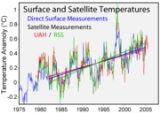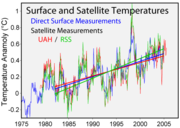
Friends of Science
Encyclopedia
Friends of Science is a Canadian non-profit advocacy organization of physicists, geologists and atmospheric scientists founded in 2002 and based in Calgary
, Alberta
. FoS believes "the Sun is the main direct and indirect driver of climate change
", rather than human activity; they also dispute the value of the Kyoto Protocol
.
Its advisors are Madhav Khandekar, Chris de Freitas
, Tim Patterson
and Sallie Baliunas
. As of December, 2009, the president of Friends of Science is Douglas Leahey.
Myth 1) Global temperatures are rising at a rapid, unprecedented rate.
Myth 2) The "hockey stick" graph proves that the earth has experienced a steady, very gradual temperature decrease for 1000 years, then recently began a sudden increase.
Myth 3) Human produced carbon dioxide has increased over the last 100 years, adding to the greenhouse effect, thus warming the earth.
Myth 4) CO2 is the most common greenhouse gas.
Myth 5) Computer models verify that CO2 increases will cause significant global warming.
Myth 6) The UN proved that man–made CO2 causes global warming.
Myth 7) CO2 is a pollutant.
Myth 8) Global warming will cause more storms and other weather extremes.
Myth 9) Receding glaciers and the calving of ice shelves are proof of global warming.
Myth 10) The earth’s poles are warming; polar ice caps are breaking up and melting and the sea level rising
 Friends of Science states that the satellite and balloon temperature records indicate no significant global warming has taken place over the last three decades.
Friends of Science states that the satellite and balloon temperature records indicate no significant global warming has taken place over the last three decades.
Friends of Science states:
Friends of Science has produced a 23 minute on-line video that contrasts the views of politicians and scientists on the question of climate change. The scientists on the video included consultant Tim Ball, Professor of Geology Tim Patterson of Carleton University, and Professor of Political Science Barry F. Cooper
of the University of Calgary, all of whom are known for skepticism with regard to the mainstream scientific view on global warming
.
Funds do not come directly from industry donors but are instead solicited for the Calgary Foundation, a charitable funds administrator which maintains a policy of not disclosing the identity of donors. The donations are then passed on to the Science Education Fund, an account at the University of Calgary set up by Prof. Barry Cooper. In the final step, the Science Education Fund uses those funds to support the activities of the Friends of Science.
Calgary
Calgary is a city in the Province of Alberta, Canada. It is located in the south of the province, in an area of foothills and prairie, approximately east of the front ranges of the Canadian Rockies...
, Alberta
Alberta
Alberta is a province of Canada. It had an estimated population of 3.7 million in 2010 making it the most populous of Canada's three prairie provinces...
. FoS believes "the Sun is the main direct and indirect driver of climate change
Climate change
Climate change is a significant and lasting change in the statistical distribution of weather patterns over periods ranging from decades to millions of years. It may be a change in average weather conditions or the distribution of events around that average...
", rather than human activity; they also dispute the value of the Kyoto Protocol
Kyoto Protocol
The Kyoto Protocol is a protocol to the United Nations Framework Convention on Climate Change , aimed at fighting global warming...
.
Its advisors are Madhav Khandekar, Chris de Freitas
Chris de Freitas
Chris de Freitas is an Associate Professor in the School of Environment at the University of Auckland in New Zealand.-Education and professional career:...
, Tim Patterson
Tim Patterson
R. Timothy Patterson is a professor of geology at Carleton University, where he is Director of the Ottawa-Carleton Geoscience Centre in Ottawa, Ontario, Canada. He is also a Senior Visiting Fellow in the School of Geography, Queen's University of Belfast, Northern Ireland. He holds a B.Sc. in...
and Sallie Baliunas
Sallie Baliunas
Sallie Baliunas is an astrophysicist at the Harvard-Smithsonian Center for Astrophysics in the Solar, Stellar, and Planetary Sciences Division and formerly Deputy Director of the Mount Wilson Observatory. She serves as Senior Scientist at the George C. Marshall Institute in Washington, DC, and...
. As of December, 2009, the president of Friends of Science is Douglas Leahey.
Position
Friends of Science publishes a list of "ten myths of climate change," each of which they disagree with::Myth 1) Global temperatures are rising at a rapid, unprecedented rate.
Myth 2) The "hockey stick" graph proves that the earth has experienced a steady, very gradual temperature decrease for 1000 years, then recently began a sudden increase.
Myth 3) Human produced carbon dioxide has increased over the last 100 years, adding to the greenhouse effect, thus warming the earth.
Myth 4) CO2 is the most common greenhouse gas.
Myth 5) Computer models verify that CO2 increases will cause significant global warming.
Myth 6) The UN proved that man–made CO2 causes global warming.
Myth 7) CO2 is a pollutant.
Myth 8) Global warming will cause more storms and other weather extremes.
Myth 9) Receding glaciers and the calving of ice shelves are proof of global warming.
Myth 10) The earth’s poles are warming; polar ice caps are breaking up and melting and the sea level rising

Friends of Science states:
- Accurate satelliteSatellite temperature measurementsThe temperature of the atmosphere at various altitudes as well as sea and land surface temperatures can be inferred from satellite measurements. Weather satellites do not measure temperature directly but measure radiances in various wavelength bands...
, balloon and mountain top observations made over the last three decades have not shown any significant change in the long term rate of increase in global temperatures. Average ground stationInstrumental temperature recordThe instrumental temperature record shows fluctuations of the temperature of the global land surface and oceans. This data is collected from several thousand meteorological stations, Antarctic research stations and satellite observations of sea-surface temperature. Currently, the longest-running...
readings do show a mild warming of 0.6 to 0.8 C over the last 100 years, which is well within the natural variations recorded in the last millenniumTemperature record of the past 1000 yearsThe temperature record of the 2nd millennium describes the reconstruction of temperatures since 1000 CE on the Northern Hemisphere, later extended back to 1 CE and also to cover the southern hemisphere. A reconstruction is needed because a reliable surface temperature record exists only since about...
. The ground station network suffers from an uneven distribution across the globe; the stations are preferentially located in growing urban and industrial areas ("heat islandsUrban heat islandAn urban heat island is a metropolitan area which is significantly warmer than its surrounding rural areas. The phenomenon was first investigated and described by Luke Howard in the 1810s, although he was not the one to name the phenomenon. The temperature difference usually is larger at night...
"), which show substantially higher readings than adjacent rural areas ("land use effects").
Friends of Science has produced a 23 minute on-line video that contrasts the views of politicians and scientists on the question of climate change. The scientists on the video included consultant Tim Ball, Professor of Geology Tim Patterson of Carleton University, and Professor of Political Science Barry F. Cooper
Barry F. Cooper
Fraser Barry Cooper is a Canadian Political Scientist at the University of Calgary's Department of Political Science. Born in Vancouver, British Columbia, he teaches courses in Political philosophy. Before coming to Calgary, he taught at Bishop's University , McGill University, and York University...
of the University of Calgary, all of whom are known for skepticism with regard to the mainstream scientific view on global warming
Global warming
Global warming refers to the rising average temperature of Earth's atmosphere and oceans and its projected continuation. In the last 100 years, Earth's average surface temperature increased by about with about two thirds of the increase occurring over just the last three decades...
.
Funding
Friends of Science says they are not funded by corporations. Critics have asserted that the Friends of Science has close links to the oil and gas industry. The Friends of Science say their "efforts to bring balance to the climate change debate are being restricted because of our lack of funding. We have mostly relied upon the good nature of our members, with some contributions from Charitable Foundations. There has also been some funding from “big oil”. But they seldom smile on us. They appear to believe that marketing is more important than historical climate information."Funds do not come directly from industry donors but are instead solicited for the Calgary Foundation, a charitable funds administrator which maintains a policy of not disclosing the identity of donors. The donations are then passed on to the Science Education Fund, an account at the University of Calgary set up by Prof. Barry Cooper. In the final step, the Science Education Fund uses those funds to support the activities of the Friends of Science.

